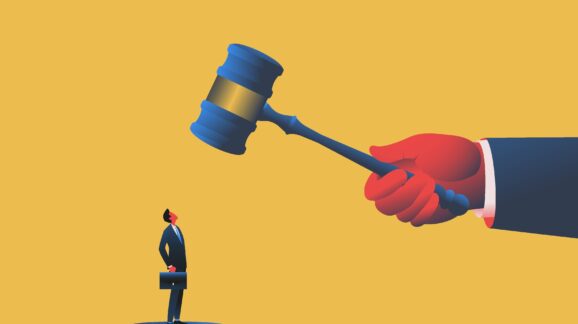Should government-favored non-profits have their own shadow courts?

Photo Credit: Getty
Imagine being sued by a private nonprofit that is sanctioned by a federal agency to enforce securities laws. The nonprofit appoints its own judges and administers court orders within its own in-house tribunal. All the while, its operatives prosecute you according to the rules implemented by said nonprofit. If this doesn’t seem real to you, think again.
Americans are slowly becoming introduced to the existence of administrative law courts (ALCs) and their administrative law judges (ALJs). While initially, the notion of federal agencies possessing their own courts may have been lost on many, high profile Supreme Court cases like Axon v. FTC (2023) and SEC v. Jarkesy (2024) are pushing ALCs into the spotlight.
Just as we begin to grasp the monumental challenge of ALCs in the federal bureaucracy, a newer form of these courts emerges. Enter self-regulatory organizations (SRO), private-sector quasi-governmental bodies that operate as judge, jury, and regulator.
SROs are nonprofit exchanges that operate under the purview of the US Securities and Exchange Commission (SEC). SROs consist of multiple private membership organizations that trade securities on the public markets.
There are approximately 50 SROs in the US, each serving as an intermediary between stock investors and the SEC officials that monitor trading activity. Many Americans are familiar with prominent SROs like the New York Stock Exchange (NYSE), the Nasdaq Stock Exchange, and NYSE Chicago.
Most Americans are likely unfamiliar with just how powerful SROs are. The SEC grants rulemaking powers to SROs, which are implemented subject to the approval of a majority vote by the Commissioners. In this sense, SROs are both private associations and quasi-governmental entities. Not only do they possess legislative rulemaking powers, they also possess their own in-house courts.
The largest SRO, Financial Industry Regulatory Agency (FINRA), has been flexing its adjudicatory muscle by targeting private investors using its ALJs.
FINRA was formed in 2007 from a merger between National Association of Securities Dealers and the NYSE’s regulatory/enforcement arm. FINRA acts as the SEC’s chief enforcer of securities regulations, overseeing broker-dealers and nearly every firm that trades securities.
FINRA recently launched a questionable (some would say frivolous) fraud suit against Frank Black and his company, Southeast Investments. FINRA alleged that Black maintained insufficient proof that he regularly visited four of his satellite offices where several employees worked remotely. For failing to preserve receipts of his travel to and from these locations, FINRA hammered Black with a $243,000 fine and a permanent ban from working in financial services.
As an SRO, FINRA’s governmental powers derive entirely from the SEC. FINRA exercised its SEC-delegated authority to prosecute Black, used its legislative venue selection power to manage the case completely in-house, and rendered judgement against him by speaking through its panel of judges.
In a situation where FINRA unfairly controls every stage of adjudication, Black’s fate was sealed from the start. FINRA’s judges upheld the fraud charge, prompting Black to appeal to their in-house appellate body, the National Adjudication Council (NAC). The NAC essentially upheld the lower court decision, only scratching off $70,000 from the amount of the fine.
The chief problem with ALCs is that there is no dividing line between court and agency. This becomes even more problematic with SROs, where the agency isn’t even an official government body. At its core, FINRA is a private corporation with its own CEO, board of governors, and corporate bylaws.
Why should a private corporation like FINRA be given license to oversee, prosecute, and render judgement against another private company?
FINRA is essentially a non-governmental agent carrying out the SEC’s dirty work, utilizing a host of extra-constitutional powers at its discretion. Moreover, FINRA’s structure and authority was never authorized by any act of Congress.
As an SRO, FINRA’s court only adds an extra wall of adjudicatory unfairness for private litigants to go through. Once Black lost his case before FINRA, he was forced to start all over by taking the matter before the SEC’s ALC, more specifically its five Commissioners, where it has stalled for five long years.
Only recently did the Commission finally administer a ruling, upholding FINRA’s NAC edict against Black. The Pacific Legal Foundation recently filed a complaint in federal court to overturn FINRA’s lifetime bar against Black from the securities industry. Since the case has now shifted into an Article III court, after stalling for many years before an ALC, this shows how regressive SRO courts can be.
SROs suit the SEC’s purposes by quashing many would-be challenges to its enforcement authority. Serving as a corporate shield for the SEC, FINRA is endowed with a set of ALJs that can run the gamut by monitoring, prosecuting, and convicting a registered firm. SEC officials need not lift a finger.
Here in lies the danger of SRO courts. They abuse their delegated authority by acting in place of the SEC to judge other private sector companies.
ALCs are becoming increasingly problematic in the federal bureaucracy. Even as Article III courts slowly begin to realize this, we are blindsided by further injustice in the form of SRO court systems.
This is why my colleague Ryan Young and I propose substantial legislative reform of ALCs in our new paper, “Conflict of Justice: Making the case for administrative law court reform.” This will resolve ALC inefficiencies and provide citizens with the chance to receive a fair trial in administrative law cases. As we can see in the case of Frank Black, that reform ought to be extended to non-profits’ SRO courts as well.